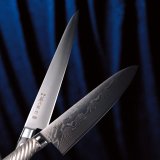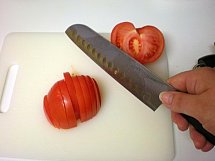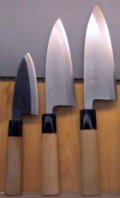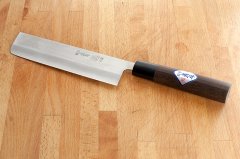
"Japanese Knives"
Made by the Best Craftsman In The World And Always
Have Been.

Japanese steel paints a picture of Japanese knives along with the Katana sword. If you are a professional cook in need of the highest quality chef knives, or even if you just want to own a great kitchen knife that is guaranteed to last for life, you may be in the market for Japanese cutlery. I am sure that you are already aware that the Cutlery knives made in Japan are highly used in restaurants all across the globe. It is incredibly hard to match the quality of these Japanese knives.
"Common Japanese Knives"

There are a few to choose from depending on your needs, the most common is a santoku hocho (Right) which is an all purpose utility knife. It ranges somewhere between 5 and 8 inches long. The name "santoku" means three virtues because it has three purposes, slicing, dicing, and mincing. The santoku is designed for a lighter and more balanced feel than traditional western style knives.

The deba bocho (right) is a kitchen cleaver; its name actually means a pointed carving knife.
It is generally used to cut meats. Its design was made to behead a fish and then run right down the spine and filet it.
They come in different sizes with the largest being at about 12 inches.
They were first developed when Samurai Swords production was replaced in the Edo Period, which was the beginning of modernization in Japan.

A nakin bocho is a Japanese vegetable knife, usually used at home to chop up the veggies, and is not used to slice through with a pulling or a pushing motion.
Just straight down to the cutting board. For professional use in a vegetable knife, you would use a Usuba bocho. (Right)
One of the main differences is that the nakin bocho is sharpened on both sides and the Usuba bocho is only sharpened on one. There are other types but as I said, these are the most common.
If you decide to order one of these knives and you are left handed, you need to let someone know because the sharpened edge is meant for a right handed person, but you can get them in either.
"Japanese Cutlery Production"

During the 19th century, there was a revolution in Japan known as the Meiji Restoration. This led to many changes in the political and social structure of Japan. In an attempt to modernize the country, the carrying of swords by the samurai was banned. The demand after that time was mostly that of the military. Though there were some sword smiths still producing the Katana swords as an art.
The rest shifted their focus to Japanese knives, Japanese cutlery. The higher quality of Japanese knives originate from the same area. Today Seki, Gifu is considered the home of modern Japanese cutlery, (Gifu Knife Hall upper left) where state-of-the-art manufacturing and technology has updated ancient forging skills to produce an excellent series of Japanese stainless steel knives and laminated steel kitchen knives. This is where all of the major players are in the field.

Miki is also a very well known place in Japan for its knife making traditions. They tend to concentrate solely on the pride of Japanese steelmaking.
Most Miki manufacturers are just small family businesses where their quality is more important than their volume.
It is not abnormal for their businesses to produce about 12 knives per day.
Just a reminder, if Japanese knives are going to be your knife of choice, and you are in the market for Japanese cutlery, a chef knife, a kitchen knife, and you are a lefty as I am, you may need to make a special order so keep it all in mind when you contact these people.
I hope you find what you are looking for, and if there is anything further that I can help you with just contact me and I’ll see what I can do.
Japanese Knives Back to Home Page
Japanese Steel
Katana Swords